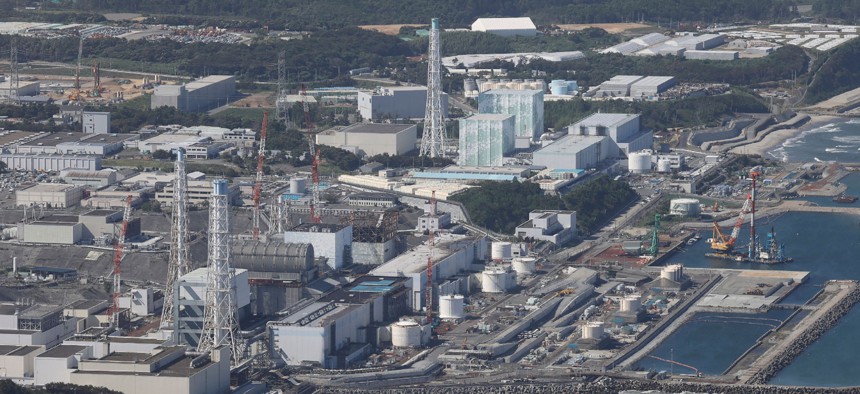
TEPCO's crippled Fukushima Daiichi Nuclear Power Plant in Okuma, Fukushima prefecture on Aug. 24, 2023. The power plant suffered a meltdown of three reactor cores after being struck by a tsunami in 2011. STR / Getty Images
Nuclear regulators should weigh climate change risk to power plants, report says
A GAO report found the Nuclear Regulatory Commission needs to factor more risk from the impact of more extreme natural events in how it licenses the safety of power plants.
With the possibility of climate change driving more extreme weather events in areas where nuclear power plants operate, the Nuclear Regulatory Commission needs to incorporate those events into the safety planning of the facilities, a new report has found.
The Government Accountability Office said in an audit Tuesday that 75 operational and shuttered nuclear power plants in the U.S. reside in areas expected to be further impacted by climate change-driven weather events like drought, extreme heat and floods.
The NRC is tasked with developing the safety regulations and for licensing those power plants, with the agency mandating that nuclear facilities are designed to withstand earthquakes, tornadoes, hurricanes and floods without harm to the public, largely by ensuring that their reactors remain cooled through a series of redundancies.
The report noted that while the NRC issued new safety requirements following the 2011 accident at Japan’s Fukushima Dai-ichi nuclear power plant — where an earthquake-triggered tsunami caused the meltdown of three reactor cores —the agency does not factor climate projections data in its safety risk assessments, instead leaning on historical data to predict potential future risk.
“In such a case, NRC expects the event to occur only once in 10,000 to 10 million years, depending on the hazard,” the report said. “NRC officials we interviewed told us that they review regional climate projections information for some hazards but do not incorporate site-specific climate projections data, which include hazard assessments, design bases or determining the adequate safety margin for plants.”
The agency also doesn’t reevaluate natural hazard or climate-related events in its license renewal process, beyond a power plant’s initial 40-year licensing period, instead focusing on its aging impacts and retaining its original natural disaster risk-informed design.
The report noted that as of January, the NRC “had issued license renewals to 49 of the 54 operating nuclear power plants, meaning most plants are operating on the basis of assessments of natural hazard risk that are over 40 years old.”
The NRC inspection process also doesn’t factor in the climate projections, but agency officials told the GAO that other criteria such as the historical record of severe natural phenomena at a power plant site — known as conservatism — safety margins and multiple independent and redundant layers of defense “provide an adequate margin of safety to address climate risks to the safety of nuclear power plants.” However, GAO officials said that the NRC has done no assessment to affirm that assertion.
“According to NRC officials, using site-specific climate projections data for extreme hazard levels in nuclear power plant design and safety reviews is challenging because of the uncertainty associated with applying these data to specific sites” the report said. “However, NRC regulations do not preclude NRC from using climate projections data, and new sources of reliable projected climate data are available to NRC.”
The report also notes that since 2017, the agency uses an information system dubbed Process for the Ongoing Assessment of Natural Hazard Information to log and document historical hazard data and assess potential risk, including events driven by climate change.
But GAO officials said that the NRC has not developed new regulations as a result of the system, hasn’t used it to assess potential changes to all natural hazards and hasn’t comprehensively reviewed natural hazards on a regular basis.
“NRC conducts POANHI assessments for one hazard at a time, and the agency does not have a schedule for reviewing natural hazards beyond the assessment of seismic hazards currently underway,” the report said. “As such, POANHI is used to react to new hazard information or events when NRC staff become aware of them.”
GAO officials offered three recommendations, including assessing whether licensing and oversight processes address increased risk from climate change, that the NRC develop a plan to address gaps in its assessment process and that the agency finalize guidance incorporating climate projections data into its processes.
NRC officials said the recommendations were “consistent with actions that are either underway or under development,” but asserted that its conservatism and defense-in-depth processes provided reasonable assurance to natural hazards and potential climate change.
GAO officials said the agency “cannot fully consider potential climate change effects on plants without using the best available information—including climate projections data—in its licensing and oversight processes.”







